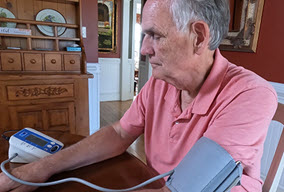‘Pivotal moment’ in women’s heart health
Female-specific results from first-of-its-kind clinical trial
Teaching first graders takes a lot of energy. So when Julia Garcia started feeling worn out, teaching became extremely difficult.

“I got very tired and couldn’t lift heavy things,” she remembers. “I had dizzy spells and could barely walk. I thought ‘my life is wreaking havoc on me.’”
Doctors struggled to pinpoint the problem, frustrating Julia and her husband Jose, both desperate for answers.
“Someone would diagnose one thing, then someone else would diagnose something else,” Jose said. “I felt helpless. We didn’t know which path to take.”
Julia’s case isn’t unusual. Because when it comes to detecting and treating heart disease, the healthcare system often tilts in favor of men.1
“Heart disease is regularly undetected, misdiagnosed and undertreated in women. Part of the reason is that historically, clinical heart research mainly studied men. So detection, treatment and standards of care often favor men over women,” said Dr. Roxana Mehran, MD, Director of Cardiovascular Research at the Icahn School of Medicine at Mount Sinai in New York.
In 2021, Dr. Mehran led an international commission studying gender inequities in heart health care. And in 2020, she became one of two principal investigators in the Medtronic SMART study.
“The SMART study finally gives us female-specific data that allows us to more effectively treat women with aortic stenosis (AS). It’s a critical step forward in treating women with heart disease,” said Dr. Mehran.
“Pivotal Moment”

The groundbreaking SMART clinical trial focused on women with AS, a potentially deadly heart condition. In patients with AS, the aortic heart valve thickens and narrows to the point that blood flow is severely restricted. Left untreated the condition can be fatal;2 treatment often requires replacement of the patient’s aortic heart valve.3 While the study looked at both men and women with small annulus (heart valves), women typically have smaller heart valves than men, so nearly 90% of the patients in the study were women.
“It’s a pivotal moment in women’s health,” said Nina Goodheart, senior vice president of the Structural Heart and Aortic Operating Unit at Medtronic. “For the first time, this trial gives physicians data from a head-to-head trial that tells them which transcatheter heart valve performs better, specifically in women with aortic stenosis. They’ve never had access to such female-specific data before.”
The trial studied 716 patients at 83 sites in Canada, Europe, the Middle East and Asia (EMEA), and the United States. It compared the performance of the Medtronic Evolut™ transcatheter aortic heart valve replacement (TAVR) system against the Edwards Sapien™ TAVR system, in patients with severe aortic stenosis and smaller heart valves. The groundbreaking findings, released on April 7, concluded that the Medtronic Evolut TAVR system performed better, particularly in terms of post-procedure hemodynamics (blood flow).
“We have to stop thinking that men and women are the same because they’re not,” added Goodheart. “A woman’s physiology is different, so she may also present different symptoms. We urgently need to start addressing this underrepresentation of women in clinical trials. That’s why the SMART study results are so important in the history of women’s health.”
In the case of Julia Garcia, who was not involved in the SMART study, cardiologists eventually determined that she too suffered from AS—her aortic valve was almost completely closed. Doctors recommended replacing her diseased valve with the Medtronic Evolut TAVR system. Cardiologist Dr. Jorge A. Alvarez of the Cardiology Clinic of San Antonio, TX, says they got to Julia in the nick of time. “Had her case gone undiagnosed much longer we may  not be talking about the positive impact we had on her,” he said.
not be talking about the positive impact we had on her,” he said.
“I wasn’t afraid at all,” Garcia said. “I was more afraid of what I had been going through. I knew I was in good hands. I felt better almost immediately after the surgery. I have a new life.”
More needs to be done

Garcia’s experience demonstrates not only the promise of heart valve replacement treatment, but also how much farther the healthcare system has yet to go in detecting and treating heart disease equally in men and women.
Even though heart disease is the number one killer of both sexes, many people don’t know the symptoms of heart problems can be significantly different for women than men.4 Even doctors aren’t always aware of the differences, and the reasons lie in the data. Research has found that female patients are included in less than 40 percent of clinical studies.5
“The SMART trial is an exciting starting point, but we have a lot more work to do to close the gender gap in medicine,” Goodheart said. “This trial shows we can change the trajectory of medical care. Now we’re going to need everyone—physicians, hospitals, governments, medical societies, insurers and companies—to work together and focus on re-shaping the future of medical treatment for women.”
Important Safety Information
TAVR risks may include, but are not limited to, death, stroke, damage to the arteries, bleeding, and the need for a permanent pacemaker.
See important safety information: https://bit.ly/43FqGf3
L001-04052024
1 The Heart Disease Gender Gap: https://www.health.harvard.edu/heart-health/the-heart-disease-gender-gap
2 Ross J Jr, Braunwald E. Aortic stenosis. Circulation. July 1968; 38(1 Suppl):61-67.)
3 https://www.mayoclinic.org/diseases-conditions/aortic-stenosis/diagnosis-treatment/drc-20353145
4 https://give.brighamandwomens.org/7-differences-between-men-and-women/#:~:text=Men%20typically%20develop%20this%20plaque,to%20the%20accumulation%20of%20cholesterol.
5 https://newsroom.heart.org/news/women-still-underrepresented-in-clinical-research-science-and-medicine-that-could-save-them-from-their-no-1-killer
Related content



